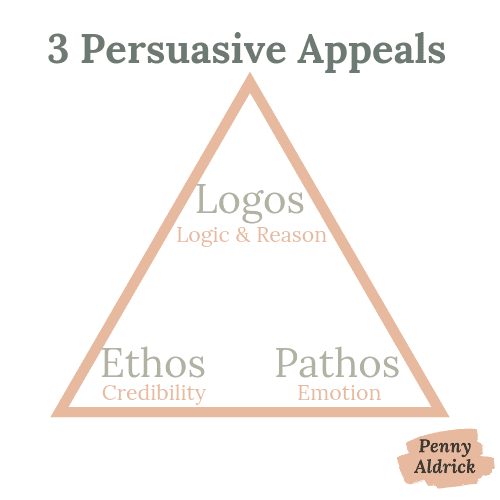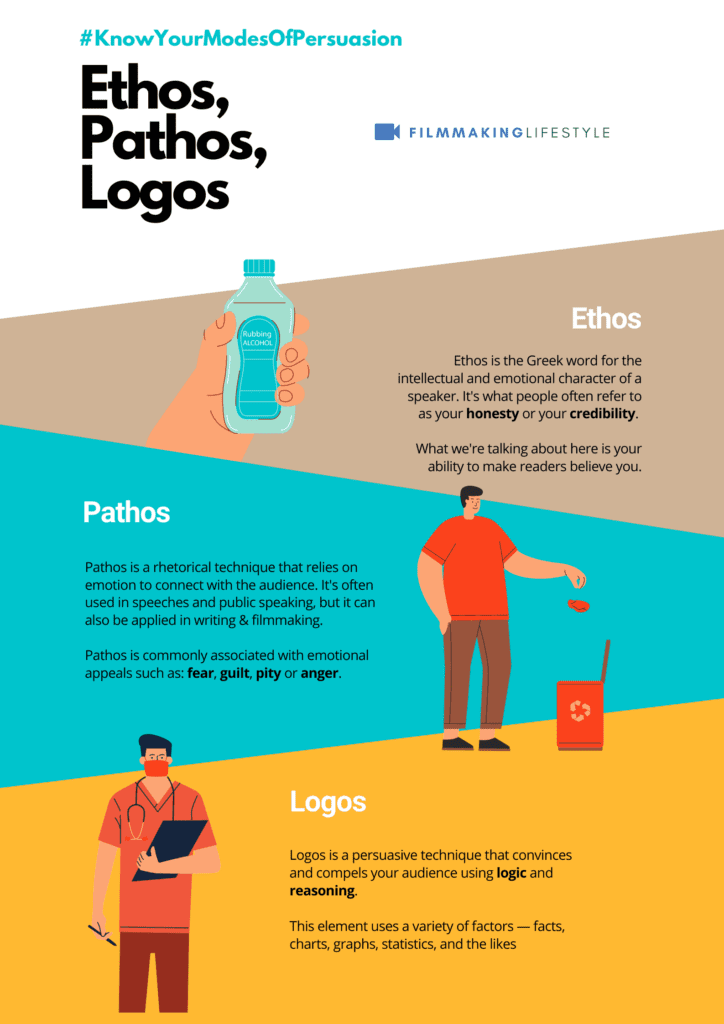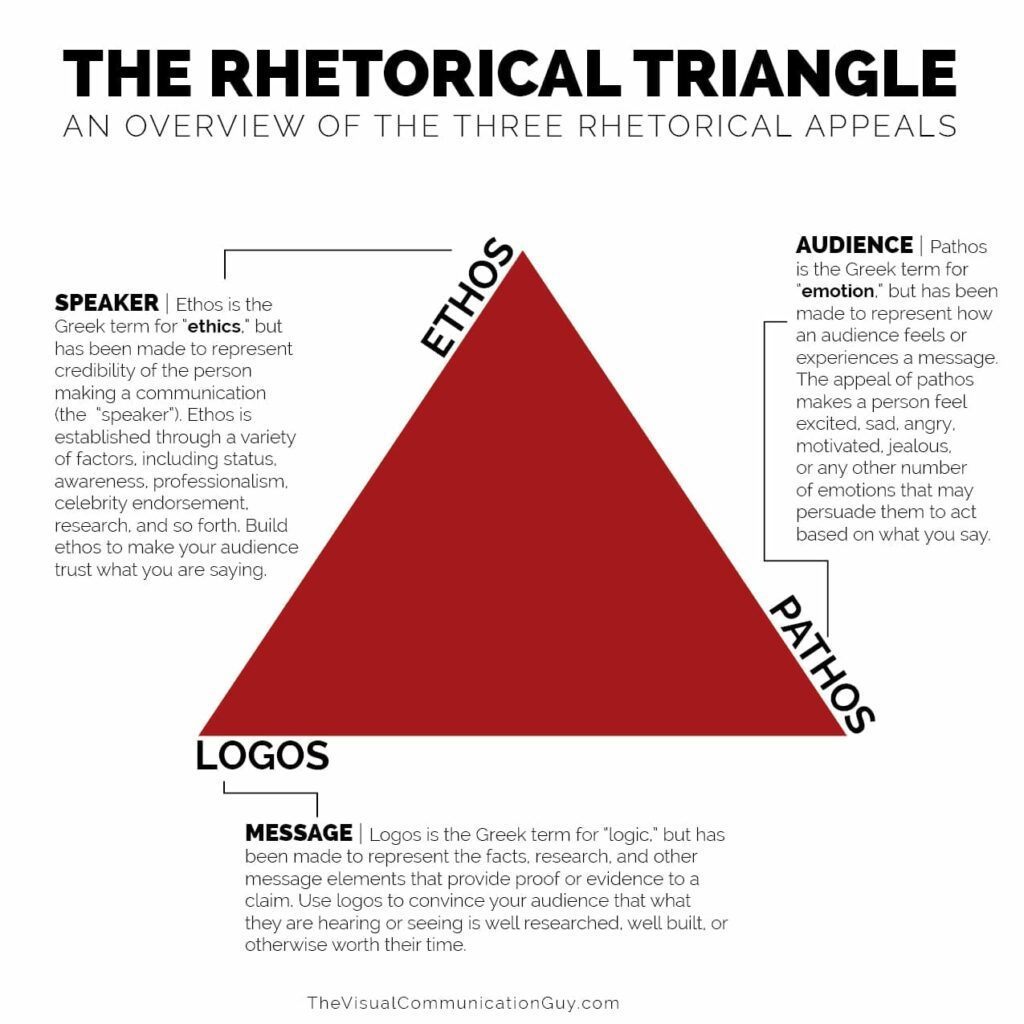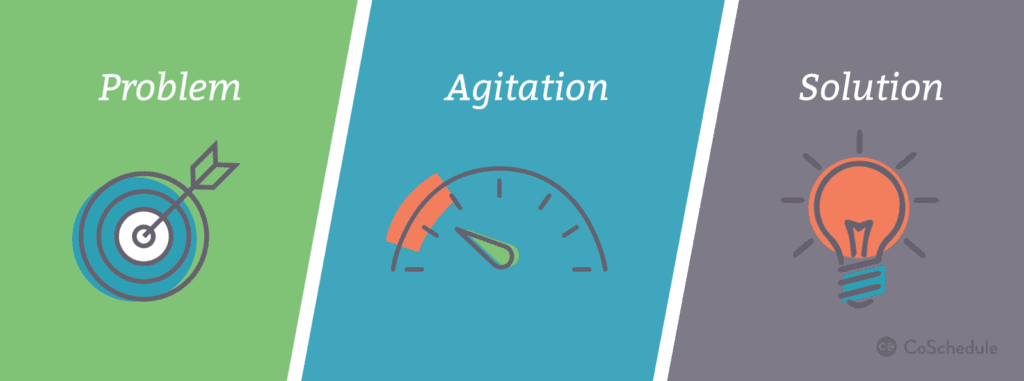Ever struggle to increase the conversion of your marketing campaigns? Does the idea of getting more sales and leads fascinate you? Then you should consider the principle of Pathos.
Sound a little daunting? Don’t worry, we have your back.
You probably spend tons of hours on your commercial, pitch, or sales copy, often to no avail. It can be frustrating.
Although that’s the case, you can turn the tables around in your favor. It may seem impossible given where you are at right now, but trust me, it’s not.
With only a few tweaks, you can improve the persuasiveness of your marketing campaigns. Luckily enough, it’s simple to do that — it’s remarkably effective too.
Then how exactly will you boost the persuasion of your campaigns?
Aristotle has got your back.
A little over 2000 years ago, this Greek philosopher discovered the modes of persuasion, which are also known as the rhetoric triangle. It was named as such because there are three of them.
Here are their explanations in a nutshell: pathos persuades the audience through emotions, ethos through social proof, and logos compels the audience by using facts and statistics.
In this article, I’m going to tell you all you need to know about pathos. You will have a practical grasp of the concept, along with the information you need on how to use it.
Here’s our breakdown of ethos, pathos, logos and what each one means:
Pathos – An Introduction
Pathos is the persuasive technique that targets people’s emotions.
These emotions can be negative or positive — it doesn’t matter because both feelings have enough power to trigger action.
On the positive side, it can be joy, love, hope, or inspiration, and on the negative angle, it can be sadness, guilt, or even anger.
Unlike other persuasive techniques that focus on facts and credibility, this one focuses on the specific prospect you communicate with through your ad.
PATHOS
What Is Pathos?
Pathos is a rhetorical device that appeals to the emotions of an audience. It’s often used in advertising campaigns to evoke feelings in order to change people’s minds or behaviors.
Pathos can be created by using emotions such as anger, humor, and sadness. It’s often seen in speeches given by public figures to sway the opinion of their listeners via appealing to feelings and emotions.
It’s important to remember that pathos is not about manipulation. Instead, it’s about getting your audience on your side in order to move them to understand you better. Smart brands know this well.
Pathos is one of the three main Rhetorical Appeals (the others being Ethos and Logos), and it can be described as an emotional appeal.
Pathos is a powerful tool in persuasion, tapping into our emotions to influence our beliefs and actions.
It’s a key ingredient in crafting messages that resonate deeply with audiences.
We’ll explore how to harness pathos effectively, ensuring your words don’t just reach the ears but also the hearts of your listeners or readers.
Get ready to unlock the secrets of emotional appeal that can make your communication truly impactful.
What Is Pathos?
Pathos represents an effective technique in persuasion, playing a crucial role in our ability to communicate powerfully.
It taps into the emotions, challenging and appealing to the hearts of the audience rather than just their minds.
As filmmakers, we recognize that a story’s emotional pull is often what grips the audience and keeps them engaged.
Strong emotional appeal can move viewers beyond their rational reservations.

Films like Schindler’s List or The Pursuit of Happyness stir emotions, compelling us to connect on a deeper level with the content and messages.
This connection is what transforms viewers into advocates for the film’s theme or cause.
Pathos is not just about sad or heartwarming emotions.
It encompasses the entire emotional spectrum capable of influencing beliefs and actions through:
- Joy,
- Excitement,
- Anger,
- Hope.
Our use of pathos extends beyond the screen.
In our marketing efforts, we leverage these emotions to build narratives that resonate with our audience’s core values and desires.
Whether through a compelling call to action or a heartwarming testimonial, pathos remains a key player in our strategy.
In storytelling, pathos is what breathes life into characters and plots.
It’s the component of storytelling that transforms characters from flat outlines on a storyboard into beings with desires, fears, and dreams.
When we execute pathos effectively, viewers often see themselves reflected in the struggles and triumphs on screen.
Understanding the power of pathos is only the beginning.
To harness it is an art that requires insight into human psychology and the dynamics of our audience.
Through mastery of pathos, we give our narratives the depth and emotion necessary to elevate them from simple entertainment to memorable experiences.
The Power Of Pathos In Persuasion
Pathos is an ancient Greek word that translates to ‘suffering’ or ‘experience’.
It’s one of Aristotle’s three modes of persuasion and is centered on an emotional appeal.
Films and speeches often employ pathos to stir emotions within the audience, compelling them to align with the presented perspective.
Our understanding of its use in persuasion is crucial—being keenly aware of the emotional strings we pull can truly transform our storytelling.
Understanding pathos isn’t just about manipulating feelings.
It’s about establishing a genuine connection.
Think of Schindler’s List or The Pursuit of Happyness – these films evoke strong emotional responses, not just through their narrative but through the way they are told.
Through the power of pathos, we can move our audience from passive viewers to active participants, emotionally invested in the story.
Successful persuasion hinges on the balance of ethos, logos, and pathos.
Ethos establishes credibility, logos appeals to logic, but pathos – it speaks to the heart.
Here are ways we can Use pathos in our films or marketing campaigns:
- Identify key emotions – what do we want our audience to feel?
- Use music, lighting, and camera angles strategically to enhance emotional impact,
- Craft relatable characters and narratives that resonate on a personal level.
Remember, effective use of pathos requires subtlety and authenticity.
When overdone, emotional appeals might come off as contrived, distancing the audience.
But when used skillfully, it becomes a compelling force, driving our audience toward the desired reaction or action.
Therein lies the power of pathos in persuasion – harnessing emotion to enrich and amplify our message.
Understanding Emotional Appeal
When we discuss pathos, we’re delving into the essence of emotional appeal – a tool central to persuasion.
It’s a potent communication technique that resonates with our audience on an instinctual level.
Emotional appeal engages our audience, ensuring they’re not just passive consumers but active participants in the narrative we’re weaving.
It colors the storyline with feelings that our viewers can personally connect with.
To master emotional appeal, we must first identify the emotions that our content aims to evoke.
Are we looking to inspire?
To comfort?
To incite action?
Each intention requires a distinct emotional strategy.
At Filmmaking Lifestyle, we understand the intricacies of using pathos in storytelling.
The nuances of emotional appeal can be found in various elements of a production.
Consider the following –
- Emotional tones conveyed through facial expressions and body language,
- Music scores that tug at heartstrings or induce excitement,
- Pacing and editing techniques used to keep viewers on the edge of their seats.
Films like Schindler’s List and Forrest Gump have harnessed the power of pathos to create unforgettable cinematic experiences.
They tap into the emotional fabric that weaves us all together.
Building a genuine connection with our audience is crucial.
We ensure the emotions we portray do not feel manipulative but rather emerge as natural components of the story.
Music and imagery go hand-in-hand in setting the emotional tone of our content.
The right melody can transform a scene, while a compelling visual can sear a moment into memory.
Crafting relatable characters is where emotional appeal starts to take shape.
Audiences see parts of themselves in the characters we create, fostering empathy and engagement.
Understanding emotional appeal isn’t just about leveraging feelings.
It’s a complex dance of authenticity and artistry.
As filmmakers, we strive not only to evoke emotions but to envelop our audiences in an experience that stays with them long after the screen fades to black.
How To Harness Pathos Effectively
Harnessing the power of pathos in filmmaking requires a keen understanding of emotional dynamics and audience engagement.
We can’t stress enough the importance of developing narratives that resonate on a profound, emotional level with viewers.
Emotional storytelling isn’t just about making audiences cry or laugh.
It’s about creating a tapestry of moments that tap into universal feelings, driving the narrative forward.
We’ve seen films like The Shawshank Redemption use hope as the central theme to create an emotional undertone that carries through from start to finish.
Music and sound design are essential tools in the filmmaker’s kit to evoke emotions.
The right score can amplify the emotional impact of a scene, transforming it from an ordinary moment to an unforgettable one.
In Inception, Hans Zimmer’s use of music shapes the film’s tension and drama, heightening the emotional stakes.
Here’s a summary of key strategies to harness pathos effectively:
- Crafting characters that audiences can relate to on a personal level,
- Creating narratives that address universal themes,
- Using music and sound design to set the film’s emotional tone,
- Employing facial expressions and body language to convey non-verbal emotions.
Remember, these are just starters for weaving pathos into your work.
Subtlety is key – hitting the right emotional notes without overplaying your hand ensures authenticity, empowering the audience to fully immerse themselves in the story we’re telling.
Crafting Messages That Resonate
As storytellers, we know that for our message to make a lasting impact it’s not enough to simply present the facts.
We must craft our narratives in such a way that they echo within the hearts and minds of our audience.
To achieve this, we jump into the ancient art of pathos.
Using this method, we’re not only relaying information but also weaving a tapestry of emotions that transforms the viewer’s experience.
Our primary aim is to strike a chord with an emotional undercurrent strong enough to buoy the entire story.
Characters experiencing challenges, triumphs, and losses become vessels for the audience’s own emotions.
We find that films like Eternal Sunshine of the Spotless Mind exemplify this, where the exploration of love and heartache transcends the screen and stirs something in the viewers themselves.
Here’s what we consider when aiming to resonate with our audience:
- Emotional peaks and valleys – crafting highs and lows that mirror the human experience,
- Relatable circumstances – creating scenarios that reflect familiar struggles and joys.
We mold characters to be reflections of our viewers.
Through their journeys, triumphs, and tribulations, we guide our audience to an empathic link, enhancing the power of the narrative’s emotional pull.
Our messages carry the greatest weight when they’re not just heard but felt.
In The Shawshank Redemption, the protagonist’s journey resonates deeply with viewers due to its sincere depiction of resilience and hope.
Our approach to pathos goes beyond the screen, into the realm of music and sound design.
By pairing haunting melodies with pivotal scenes or using the quiet stirrings of silence to highlight a moment, we open up another avenue for the audience to connect.
Sound becomes an invisible thread that ties the viewer’s emotions to the visual tapestry of the film.
By engaging in these practices, we’re not just filmmakers or marketers but also architects of experiences.
We build a bridge of empathy that enables our audience to not only see but also feel the essence of the narratives we create.
Through the strategic use of pathos, we craft messages that resonate far beyond the final credits.
What Is Pathos And How Do You Use It – Wrap Up
We’ve explored the multifaceted nature of pathos and its undeniable power in persuasion.
By tapping into a spectrum of emotions, we can forge a deep connection with our audience—whether it’s through a compelling film or an impactful marketing campaign.
Remember, the key to harnessing pathos is a blend of subtlety and authenticity.
It’s about creating messages that don’t just inform but resonate on a profound emotional level.
When we craft our narratives with this in mind, we’re not just speaking to our audience; we’re reaching their hearts and minds, leaving a lasting impression that drives them to action.
Frequently Asked Questions
What Is Pathos In Persuasion?
Pathos is an element of persuasion that taps into the audience’s emotions to create a connection and enhance the effectiveness of communication.
It goes beyond logical arguments and can encompass a range of feelings from sadness to joy.
How Do Films Use Pathos To Connect With Viewers?
Films use pathos by eliciting specific emotions through storytelling elements such as relatable characters, universal themes, strategic music and sound design, and visual storytelling techniques, creating a deep connection with the audience.
Can Pathos Include Emotions Other Than Sadness?
Yes, pathos includes a wide spectrum of emotions, not just sadness.
It can involve joy, excitement, anger, hope, or any other emotional state that helps forge a connection with the audience.
Why Is Pathos Important In Marketing And Storytelling?
Pathos is important because it helps to humanize a message, making a story or marketing campaign more relatable and memorable by appealing to the audience’s emotions, which drives engagement and action.
How Can You Use Pathos Effectively In Your Communication?
To use pathos effectively, identify key emotions you want to elicit, use music and visuals to set the emotional tone, and develop relatable narratives and characters.
Remember, subtlety and authenticity are crucial for a genuine emotional impact.
What Role Does Music And Sound Design Play In Creating Emotional Appeal?
Music and sound design dramatically enhance emotional appeal by setting the tone and mood, influencing the audience’s emotional response, and accentuating emotional peaks and valleys in the narrative.
What Is The Ultimate Goal Of Understanding Emotional Appeal In Communication?
The ultimate goal is to envelop the audience in an engaging experience that resonates on a personal level and stays with them, moving beyond mere information to evoke an authentic emotional response.








